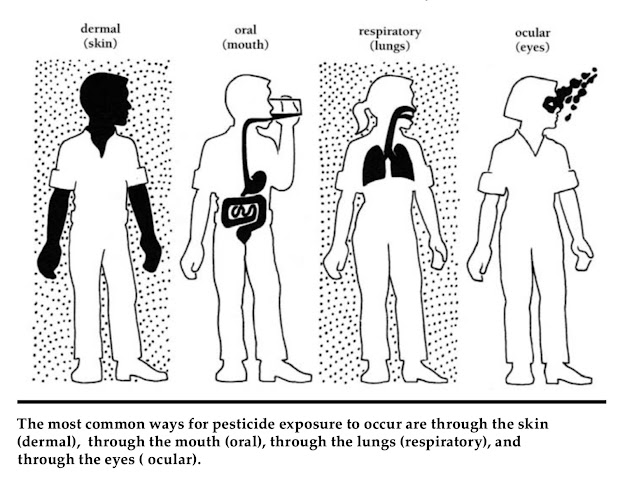
Be careful around garden chemicals; important safety tips to remember

|
| (Illustration courtesy UC Integrated Pest Management, Pest Note 74126) |
Pesticides can do more than kill unwanted insects; they can harm you, too.
Cherry Hoover found that out the hard way while cleaning out her garage. That included pesticides, miticides, insecticides, herbicides, fungicides and other chemical cures that had accumulated over several years. (Remember: The suffix “cide” means “killer.”)
Hoover is president of the Sacramento Floral Design Guild and a national award-winning rose exhibitor and arranger. She has been a dedicated gardener most of her life. She’s handled lots of garden chemicals.
But she let her guard down while packing up boxes of old chemical containers.
“I thought I was doing the right thing,” Hoover recalled. “I almost lost my sight in one eye.”
The culprit: Her cellphone. Hoover had her phone with her while she was working. “I somehow got some chemicals on my hands and then got them on my phone,” she recalled. “Then, I touched my phone (without gloves) and must have touched my face.”
Specks of the unidentified chemical managed to migrate into her eye.
“My eye was paralyzed,” said Hoover, who had to go to the emergency room. “My pupil was frozen open for nearly two weeks. My doctor wasn’t sure it would ever go back (to normal). I couldn’t sleep. It was terrible.”
Fortunately, it was a small enough amount that its effects eventually wore off and Hoover’s eye returned to normal. But her experience was a cautionary reminder: Be extremely careful and alert when handling dangerous chemicals.
“The dumbest things can get you,” said Jolene Adams, former president of the American Rose Society. For local rose clubs, Adams recently led a workshop on chemical safety, her specialty.
Dangerous chemicals can be absorbed quickly, almost instantly, through our skin, nose, mouth and eyes.
“Dermal – through your skin – is the most common,” Adams explained. “You can accidentally splash something on your skin or pick something up.”
Nose and eyes often are overlooked as pathways for chemicals to enter our bodies, Adams noted. “The moist skin inside your nose loves to attract dust. Your eyes are very sensitive.”
When handling any chemicals, wear protection, she said.
“Use chemical-resistant gloves – not vinyl, not rubber, not hospital gloves,” Adams said. “Chemicals will go right through most household or vinyl gloves. But don’t stop there. Wear chemical-resistant shoes, too; not tennis shoes and definitely not sandals.”
Adams also urged the use of safety goggles, a face shield, a hat and a respirator. Use a N-95 facemask at a minimum. She recommends use of protective clothing such as disposable paper coveralls. Always wear long sleeves and pants when working with chemicals.
Better yet, use fewer chemicals. Wean your garden off pesticides and herbicides. Most problems can be solved by other means, such as integrated pest management, she noted.
When you do buy chemicals, buy the smallest amount – not the largest package, Adams said.
“Never bulk-buy garden chemicals,” she said. “They degrade over time. If you buy less, you have less to get rid of later.”
Never pour chemicals down the drain or mix them together, she added. Always keep them in their original containers with all the warning labels. When disposing of them, do it properly via your city or county’s waste disposal services.
And just in case, memorize the emergency number for Poison Control: 1-800-222-1222.
An excellent guide to pesticide use and safety from the UC Integrated Pest Management system can be found in Pest Note 74126 .
Comments
0 comments have been posted.Sacramento Digs Gardening to your inbox.
Food in My Back Yard Series
May 6: Maintain soil moisture with mulch for garden success
April 29: What's (already) wrong with my tomato plants?
April 22: Should you stock up on fertilizer? (Yes!)
April 15: Grow culinary herbs in containers
April 8: When to plant summer vegetables
April 1: Don't be fooled by these garden myths
March 25: Fertilizer tips: How to 'feed' your vegetables for healthy growth
March 18: Time to give vegetable seedlings some more space
March 11: Ways to win the fight against weeds
March 4: Potatoes from the garden
Feb. 25: Plant a fruit tree now -- for later
Feb. 18: How to squeeze more food into less space
Feb. 11: When to plant? Consider staggering your transplants
Feb. 4: Starting in seed starting
Sites We Like
Garden Checklist for week of May 11
Make the most of the lower temperatures early in the week. We’ll be back in the 80s by Thursday.
* Plant, plant, plant! It’s prime planting season in the Sacramento area. Time to set out those tomato transplants along with peppers and eggplants. Pinch off any flowers on new transplants to make them concentrate on establishing roots instead of setting premature fruit.
* Direct-seed melons, cucumbers, summer squash, corn, radishes, pumpkins and annual herbs such as basil.
* Harvest cabbage, lettuce, peas and green onions.
* In the flower garden, direct-seed sunflowers, cosmos, salvia, zinnias, marigolds, celosia and asters. (You also can transplant seedlings for many of the same flowers.)
* Plant dahlia tubers.
* Transplant petunias, marigolds and perennial flowers such as astilbe, columbine, coneflowers, coreopsis, dahlias, rudbeckia and verbena.
* Keep an eye out for slugs, snails, earwigs and aphids that want to dine on tender new growth.
* Feed summer bloomers with a balanced fertilizer.
* For continued bloom, cut off spent flowers on roses as well as other flowering plants.
* Add mulch to the garden to maintain moisture. Mulch also cuts down on weeds. But don’t let it mound around the stems or trunks of trees or shrubs. Leave about a 6-inch-to-1-foot circle to avoid crown rot or other problems.
* Remember to weed! Pull those nasties before they set seed.
* Water early in the day and keep seedlings evenly moist.